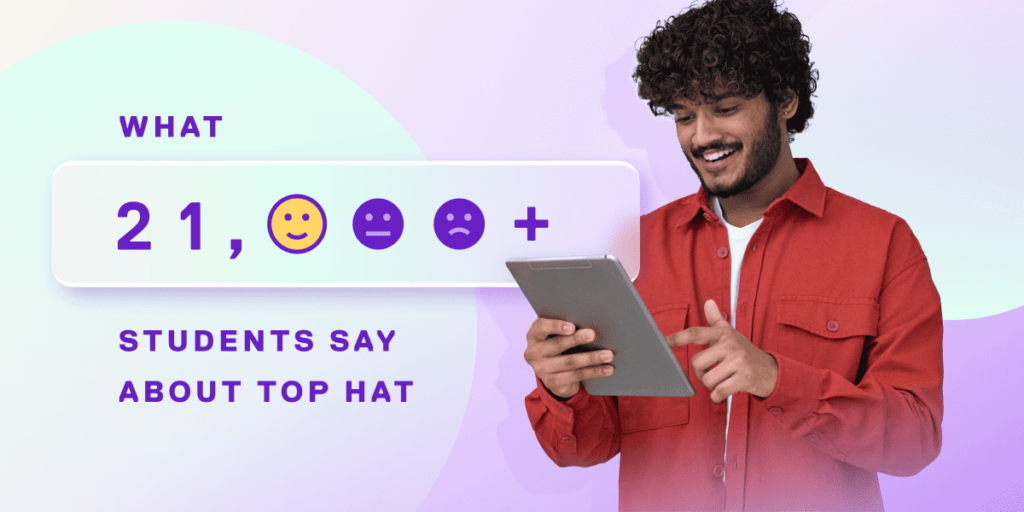In a recent Top Hat survey of North American professors, only 30 percent of instructors said that the majority of their class read the assigned textbook, and barely 40 percent said their students bought the texts at all.
Even when a student purchases a textbook, they’re not guaranteed to read it cover-to-cover. So if that’s the case, then how are students actually using their textbooks?
They’re reading it only when they have to
Andrea Hendricks, who teaches college algebra at Georgia State University, says that in her experience students are ‘learning to the test’ rather than gaining understanding. “For the last 12 years, I’d observed that students would often complete their homework assignments with 100 percent accuracy but, then, on their exams, fail to demonstrate the knowledge behind those assignments,” she says. “They were hacking their way through the course, trying to find the route that demanded the least amount of time.”
There are many demands on students, not least because of demographic and financial changes in the past decade or two. Increasing numbers are having to work to support themselves through college; many others have family commitments and/or are coming to higher education later in life. To them, it might make sense from a lifestyle point of view that students are looking at the hours of each day and deciding that time spent on background reading isn’t going to directly contribute to their goals.
To try to mitigate this, make sure your textbook and course materials are integrated more fully within your class, as early as you can. Here are some suggestions for doing this.
They’re buying it at the last moment
Price is, of course, an important factor as well. Students can’t learn from textbooks they can’t afford, and if they have to save up from the beginning of the course for a $200–$300 textbook, to buy it a week before the midterms, they’re forced to play catch-up for the rest of the semester—risking their grades, and even their completion of the course.
A recent study at the University of Georgia, co-authored by C. Edward Watson, proves this point. When eight free textbooks were implemented across several courses, the number of students achieving A and A- increased, and DFW rates among Pell recipients fell by 4.43 percentage points to 10.13%. (The DFW rate is the proportion of students who get D grades, fail or withdraw; Pell recipients receive Pell grants toward tuition fees, based on financial need.)
There’s not much you can do directly as a professor about your students’ financial situation, but you can try to ease the burden on them by opting for low-cost or free materials for at least part of your course; OpenStax is one option.
They’re going elsewhere
The bane of pub trivia quizzes, Wikipedia has long since become a fast dispensary of information for students, too. It’s often far easier for a student to do quick background reading on an upcoming topic there, using the cellphone that’s always in their pocket, than to fish through an assigned print textbook probably not at hand.
Wikipedia can be an extremely useful reference tool, provided that students understand its collaborative nature—and that any information on there should always be checked with the original sources. But students that rely on it, and other non-academic sources, exclusively can be focusing on the incorrect topics; or worse still, be learning incorrect information.
Professor Andrew Wegmann, who teaches history at Delta State University, managed to mitigate this problem by switching to a digital textbook. He found that his assigned homework now results in better engagement: “Students respond to the text now, they don’t copy out websites,” he says, adding that making a digital course the authoritative version scratches “the Wikipedia itch.”
What’s more, the teacher also gains control over where their students are getting information (all-important now in the era of misappropriated and poorly-sourced material).
Another way forward
If you’re experiencing any or all of these issues in your class, consider Top Hat as a solution. Top Hat offers digital textbooks and in-class engagement; you can see which students are engaged and paying attention to the readings you’ve assigned by seeing their responses to questions right inside the textbook content. Top Hat textbooks are 40 to 60 percent less expensive than books from traditional publishers, which helps to mitigate issues around pricing. And the fact that they’re based on students’ own devices makes them easy to reference and browse independently.


